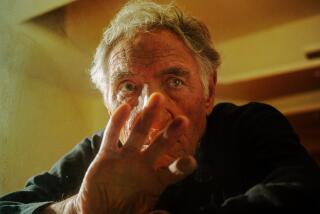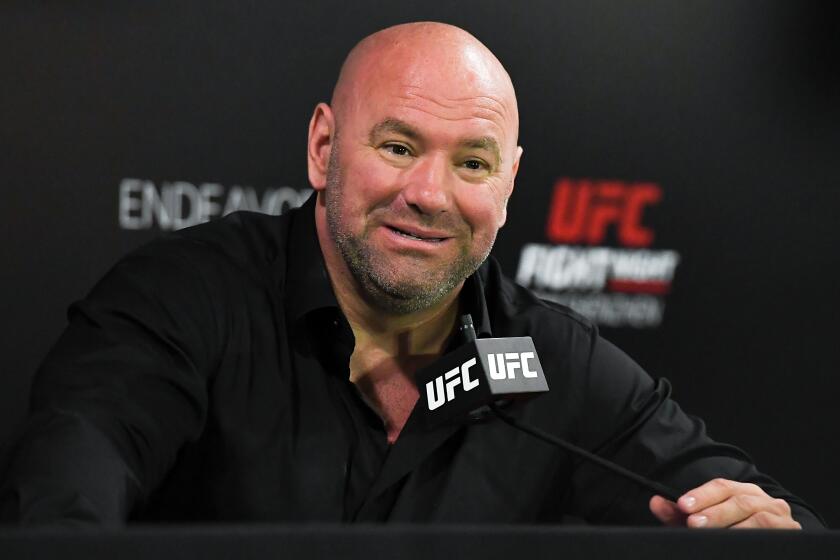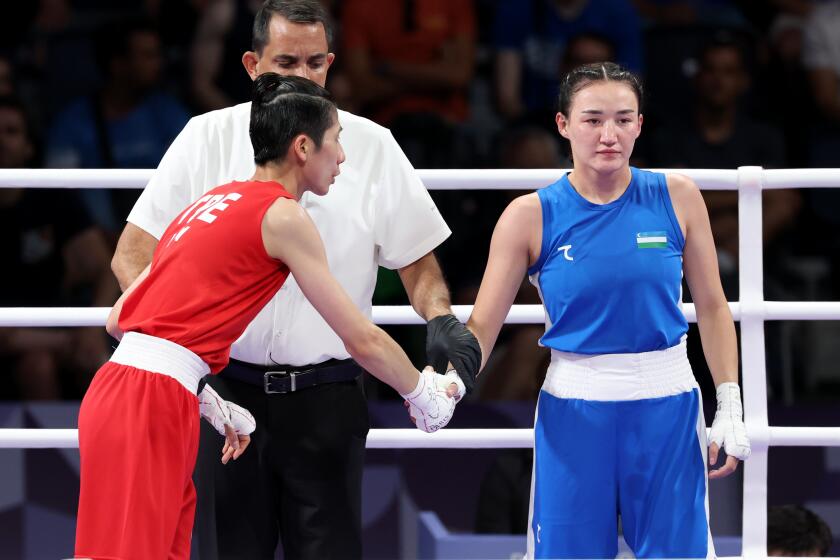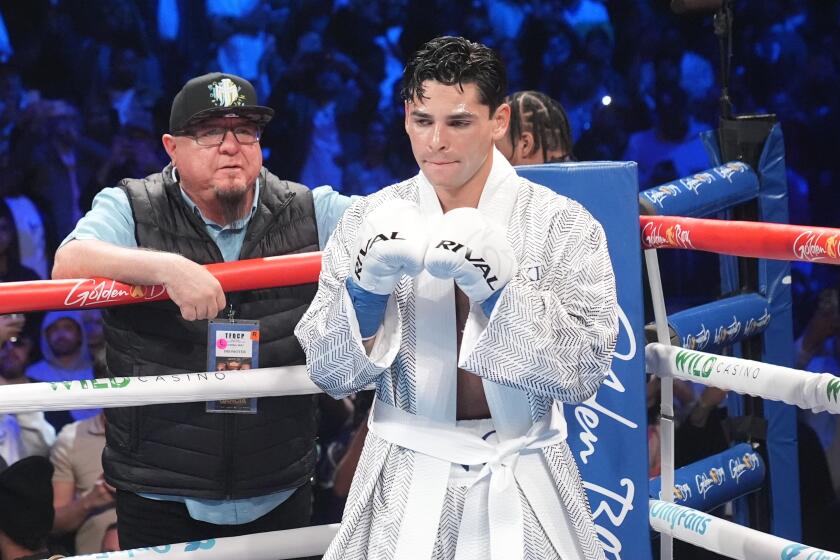The Streets, the Ring and the Demons of Al Stankie : Big Heart, Big Mouth, an ex-Cop Burns With the Fire to Make Champions Out of Kids From the Projects
IN A VIOLENT SPORT, IN A VIOLENT CITY, AL STANKIE HANGS ON. HE IS a man of sweat and physical force, a trainer of young boxers. He understands pain, fatigue and the human spirit. At 53, Stankie has known the exultant rush of triumph in the Olympic Games, the heartache of abysmal failure, even jail.
Now if he can only figure himself out, maybe there is time, maybe a way, to live out the fairy tale he imagines for himself. Then Stankie could ascend to his rightful place--a great figure, creator of champions, astride the world with arms outstretched to the stars. The dream fills him, drives him through the miles, from the gyms to the fights; it propels him through the barriers of his own agony. He can see it, almost believe it, and yet that one rub: Stankie remains an enigma, even to Stankie. He is, and has been, his own fiercest enemy.
For all he preached discipline, Stankie lost his wife and home for lack of it. For all his soft-hearted generosity--he has given away thousands to poor families in L.A.’s dismal housing projects--the former cop is remembered most, by some in boxing, for his explosive side: the barroom fights, the tantrums, the drunken binges that have driven away friends and promising fighters.
That is his history, and Stankie is out to change it. He has sworn off the alcohol. He is taking medication to control a metabolism that used to rage like a tropical storm. Despite his troubles, he is relentlessly positive. When holding court in the corners of slick-walled rooms emblazoned with boxing posters, his charisma electrifies the air. He talks the street rap of the projects. He flashes his leering grin, tells ribald stories, stirs young minds with war whoops and kick-ass bravado. Yet he struggles. Immense inner forces show themselves in his eyes--defiant, sad, kindly, angry, laughing eyes.
Street-bred fighters, some of them former gang members, hang on his words, and Stankie seems to tower over them, not only physically, at 6-foot-2, but also in dramatic presence. The gestures are ungainly, a series of lurches and contorted hand movements, as if he is reining back enormous power. His dark hair, graying at the temples, is pulled back in a short ponytail, and he wears a dangling earring, a rebel look. The voice is like leather, roughened by years of hard use.
“I’ve got the ability to build and make champions,” Stankie says. Two Olympic gold medalists--Paul Gonzales, in 1984, and Oscar De La Hoya, in 1992--are evidence to support the claim. “I’ve got the ability to motivate. The bottom line is making champions. I can make champions.”
Gonzales believes. He won the gold fighting four bouts with a broken hand, in such searing pain that he bit a hole in his mouthpiece. What gave him that grit? “He had an Al Stankie (training him),” Gonzales says now. “To me, he’s the best in the business, by far. Anywhere.”
But Stankie let De La Hoya slip away by landing in jail for 84 days, 83 of them in solitary. So while his former protege scales the heights of a brilliant young professional career, Stankie toils in the shadows, on a level below the media darlings. He is seen in myriad different lights. Loony. A Damon Runyon character. A screw-up. A Mother Teresa figure. A great man. A loser. A Robin Hood. A misguided missile.
“Al Stankie is a legend,” says Alex Sherer, trainer of Thomas (Hitman) Hearns. “He’s had his demons to battle, but I think Stankie’s back on the rise. He’s a stand-up guy. If you were in a fight and had 50 guys chasing you down an alley, Al Stankie’s the one guy you would want to be there with you.”
Tales of Stankie’s largess loom larger than life. Adrian Arreola, who would become a national Golden Gloves champion, remembers one rainy winter day, years ago, when Stankie was walking with him near the Aliso Village housing project in East L.A. They encountered a transient, cold and barefoot. Stankie stopped and gave him the shoes off his feet. “I said, ‘Al, why did you do that?’ ” Arreola recalls. “He said, ‘Someday God will do something nice for me.’ ”
Stankie was a cop then, working the projects and training teen-agers as part of a boxing program run by the L.A. Police Department. But the wobble of some broken inner gear already was twisting him. He began running wild at all hours--drinking, fighting, lashing out against the family members and friends who would try to corral him, yielding to all those same evils he fought to quell.
“I didn’t drink, I swam in it.” he recalls. “I didn’t burn bridges, I blew them up.” All those pyrotechnics cost Stankie his best fighters, his wife, his five-bedroom home in Cerritos, nearly every cent of his life’s earnings--and possibly his LAPD job. Clare MacCarley, Stankie’s girlfriend until recently, describes him as a tragic figure but a spectacular human being. “He’s the type of person who will give you the last dime out of his pocket,” she says. “If I’m low on money, he’ll say, ‘Here, take my week’s pay.’ He’ll walk away with nothing and whistle and not care. He’ll go without eating. As long as everyone else is eating.
“People like that, the ones who take risks in life, the ones in the limelight, they fall. And he fell.”
*
So now, on a bright fall morning, another moment unfolds: the embattled trainer, in high spirits, in the canary-yellow workout room of the VIP Boxing Academy in Venice. Stankie is showing off two of his half-dozen or so latest proteges--smiling, confident fighters whose chiseled bodies look like Rodin sculptures. One is Israel Cole, 28, a cruiserweight from Sierra Leone, West Africa, once that nation’s hope for glory in the 1984 Olympic Games before losing in the quarterfinals of the junior middleweight tournament and embarking on a lackluster professional career. The other is David Sewell, 31, another cruiserweight who is a former all-U.S. Army boxer, now undefeated as a professional.
“To have two champions in the same stable--we’ll do it!” Stankie cries out. “Israel Cole can be a world f---ing champion. And David Sewell, you see him play football, see him play basketball. He slam-dunks on those guys. You see him run, like a deer!
“All of a sudden, God gave me these guys. I say, ‘Lord, thanks for keeping me going.’ ”
Sewell grins. “The first time we met, we got along good.”
“You know why?” Stankie bellows.
Both the trainer and fighter answer in unison: “Because I kicked his ass!”
And they laugh.
*
STANKIE’S FIRST FALL, THE ONE THAT CHANGED EVERY PRIORITY IN his life, setting in motion the chain of events that would lead to far more painful descents, was this: “I fell in love with the kids.” They were the youngsters in the barrios that Stankie patrolled during much of the 1970s and 1980s, the kids without jackets, the ones without milk in the refrigerator, the children whose fathers had gone and whose mothers were alcoholics.
That world became Stankie’s obsession. He saw what needed to be done and he endeavored to do it, buying the kids dresses, jeans, hamburgers--whatever might help. He moonlighted and spent his own family’s savings and made deals to move families out of the projects and into cleaner, safer apartments: If they came up with the first month’s rent, he supplied the last.
He likened himself to Johnny Appleseed, planting the seeds of hope in the ghetto, and the Pied Piper, leading youngsters toward a better life. Or he was “Peter Pan’s Uncle Al,” as if he were magical. Stankie’s coffee-colored van was dubbed Tinker Brown, after the pixie fairy. “Tinker Belle flies through the air,” he would explain, “and Tinker Brown flies on the ground.”
In squalid environs unaccustomed to heroes, Stankie won over families willing to forgive his roguish ways. “I could go down to the projects, a white ghetto cop, and not worry about getting blown away,” Stankie, an officer until 1986, boasts. “I got involved in some bad things there. When the guys were selling drugs to some of the fighters . . . that’s when I’d get my guns out. You point a .38 (police revolver) in their nose and say, ‘I told you not to sell drugs to my babies,’ and you crank one off in the air, it brings their attention--fast!”
With eyes inflamed with intensity, Stankie seems to be reliving such an instant in the film noir of his life. During his free fall, such jarring moments formed a montage of triumph and chaos, great hopes and squandered opportunity. Even Gonzales, his prize pupil, became so alienated by Stankie’s ranting drunks that the two men split bitterly in the late 1980s, going separate routes, like the broken fragments of some exploded rocket streaking down from the upper stratosphere. Gonzales, only 24, struggled with his injury-marred professional career. “He fought nine times in four years and lost three of them,” Stankie recalls, still piqued despite a recent reconciliation. “He fought with me 230 goddamn times and lost two .”
Stankie fared even worse. Incidents piled up. Stankie tells of one late-’80s barroom brawl in which three thugs began harassing a security guard. Stankie intervened, decking one man and chasing the others away. The ensuing toasts left him cross-eyed drunk when he hit the road, at which time he rammed another car and cracked his head on his own windshield. Two bystanders tried to help him. He cussed at them and “crashed their heads together.” He was arrested for felony drunk driving and carrying a hot gun. He served 13 days in jail.
By the time it all bottomed out, he was as ravaged and senseless as any pugilist who ever found the canvas. Four drunk-driving arrests in a single month were part of his passport back to jail in 1991. But in a gray, windowless cell, he received a letter that would foster his comeback.
The correspondence was from his son, Andy Stankiewicz, a baseball player in the New York Yankees system. Andy told him that to stand maybe Stankie needed to get on his knees. Stankie listened. He prayed. He cried. And he began to rise. In uncertain steps, he dances to the yin and yang rhythms of wisdom and fury, looking to land that one big haymaker, that shot at a title for one of his athletes. Only that, he believes, will be enough to redeem himself, to show the world that Al Stankie is back.
*
The tattered piece of paper contains a biblical quotation that Andy sent him. Over breakfast at a crowded Venice diner, Stankie unfolds it from his wallet, proud to show off the verse from the book of Isaiah: “But those who hope in the Lord will renew their strength; they will soar on wings like eagles; they will run and not grow weary; they will walk and not be faint.”
Like a man reaching for higher virtues, Stankie surrounds himself with favorite bits of inspiration. On the same page is Max Ehrmann’s 1927 poem, “Desiderata,” with its eloquent appeal for placid thought, for humility, for gracefully surrendering the things of youth. “I can’t do that,” Stankie laughs at that last thought.
Later, after his fighters’ workouts in the Venice gym, he becomes serious, acutely aware that future successes will rest on his own stability. “My problem was, I’d be climbing the mountain and I’d fall,” Stankie says. “Now, I’ve learned to dig in. The storm comes, you dig in, wait till the storm’s over. Then you come back out and keep climbing.”
Around the room are plaques and mementos: The honorary mayor of Boyle Heights. An award from the Police Protective League. A proclamation from the City of Los Angeles lauding his work in the housing projects.
Overlooking the ring is a framed, life-size photograph of a friend, a fighter familiar with life’s ups and downs. The handwritten inscription reads: “To Al, God bless and remember, he alone is victorious who conquers himself. Best wishes. Muhammad Ali.”
*
A MILD SPRING NIGHT, EARLY 1990, TINKER BROWN ROLLS THROUGH the streets of East L.A. In just hours, one of Stankie’s fighters, 19-year-old Ernesto Tobias Jr., will be boxing at the Great Western Forum. Stankie is out rounding up a few of Tobias’ friends so that they can be there.
These are Stankie’s dark times. The trainer at times sounds inebriated, righteously angry. He rants about the breakup of his marriage, the drugs and violence of the streets. Of Tobias, with whom he has clashed repeatedly over several years, Stankie is brutally candid. The fighter, he says, was a bad kid, a kid who’d been in jail not once but several times, a kid who’d been shot in drug deals, a kid who had to be kicked out of the gym time and again for fighting dirty.
“I’d keep saying, ‘If you don’t change your rules, you lose, because I’m never going to change my rules.’ ” Stankie snarls, looking for street signs. At intersections, he stops, glances and runs the red, traveling east on Brooklyn Avenue, jogging south to Whittier Boulevard. He complains that he needs a beer. He talks about inspiration, about preaching the “ABCs backward: Anything you can conceive in your mind and believe in your heart, you can achieve.”
From memory Stankie likes to quote Theodore Roosevelt: “Far better it is to dare mighty things, to win glorious triumphs, even though checkered by failure, than to take rank with those poor spirits who neither enjoy much nor suffer much, because they live in the gray twilight that knows not victory nor defeat.”
The words are Stankie’s credo, his rationale for being different, for getting involved with the lives of inner-city children. Tobias, who will lose this night on a split decision, is a vivid example of that philosophy. Tobias is from Aliso Village, one of six children in a family dogged by tragedy. His father and a brother, Paul, were killed in separate incidents by gang gunfire. His mother, Molly, died of an apparent heart attack while trying to kick a heroin addiction. And a sister, Myra, died of a cocaine overdose.
Through all the misfortune, Stankie was there, providing rent money, food and support. “We used to eat tortillas and mayonnaise, or bread with syrup,” because the family was too poor for anything better, Tobias remembers. But Stankie brought Cheerios, ground beef. Later, he contributed several months’ rent so that the family could leave the projects.
At 13, the young fighter learned the facts of life from Stankie. At 15, Tobias was shot four times and dropped from a third-floor landing by jealous gang members who left him for dead. After a month in a coma, he opened his eyes at L.A. County-USC Medical Center to see Stankie staring down at him, crying.
“He was like . . . my guardian angel,” Tobias recalls. Nearly every weekend, Stankie invited barrio youngsters to his home for cookouts and overnight pool parties, showing them the lifestyle they might achieve. At times, they numbered 10 or 11, and occasionally they stole his wife’s jewelry, creating strife in the marriage. But Stankie refused to keep them away.
And so over the years there grew a long roll call of beneficiaries, not all of them boxers. They were anonymous faces of the inner city:
There was Jorge Fernandez, a fatherless youngster from the cardboard slums of Mexicali, Mexico, struggling to learn English, who not only attended the parties but also attended school, because Stankie called there regularly to be sure he was in class.
There was Tommy Hernandez, his mental gear works stripped by a cocaine-induced coma, who became Stankie’s special guest at a mountain training camp so that he could run along with the boxers and breathe the clean air.
Then there was Louie Morales, a young musician whose song Stankie hustled at a Spanish-language radio station, getting it air time. After that, Stankie spent $1,200 for speakers so that Morales could perform in public. And they’d known each other barely a month.
Stankie, who was a police officer then, using money he had set aside by working nights and selling life insurance, remains devoted to the poor, even now that he is among them. Boxing is an avenue of salvation, as he sees it. “That ring is the ring of life,” he says. “You can’t cheat. You can’t gangbang. They learn respect in that ring. They learn to be better people.”
Now, no longer in uniform, he’s pulling on a sleeveless shirt before a workout, but he still bleeds for the city’s impoverished youngsters. He understands their wants. “I know what it’s like to be hungry, to have cereal with water,” he barks harshly. “After a while, I liked goddamn sugar water more than I liked milk, because we didn’t have the milk . . . and I got used to it.”
As a child, he’d have dreams, Stankie remembers. “I’d dream of something I had, and I had it, in my hand. A quarter or dollar, whatever it was, I got it. I got it! And I’d wake up . . . .” He stops, stares at his open palm, at his long fingers. “Oh. It was just a dream.”
SCREAMS DRIFTED INTO THE BEDROOM. TWO TERrified young children, Alfred and Irene, hid there, reciting Hail Marys, because their mother and father were at it again--another fight, another long, dark night in Erie, Pa., 40 years ago. As a meat-cutter, John Stankiewicz earned decent money; as an alcoholic, he spent it. One year his wife, Virginia, a staunch Catholic, served young Al, Irene and Theresa a Thanksgiving meal of canned chicken-noodle soup. In a dysfunctional household, the children bonded.
Al Stankiewicz was a model youth--glib, popular, tall and dashing. With his abusive father, he showed compassion. His father’s long disappearances would end with Al going to find him, drunk in his car, and hauling him home. From his mother, who still bowls, at age 72, Al was endowed with athletic talent. He is remembered even now as one of the greatest performers ever at Cathedral Preparatory School, a Catholic sports powerhouse in downtown Erie.
A plaque there commemorates the city pole vault championship young Stankiewicz won in 1959, clearing 12 feet, 5 inches on a bamboo pole, a school record that lasted 18 years. In basketball, Al was voted Erie’s outstanding prep player after leading his team to the city title.
But Erie could not contain him. In 1962, he dropped out of Gannon College, leaving his weeping first love for the lure of California beach life, landing in Venice, partying, raising hell, meeting women.
One of them was Esperanza (Hope) Morales, a flirtatious, dark-eyed customer at the shoe store where Stankiewicz took a job.
They fell in love and married, and Al enrolled in the Police Academy. Before long, they had three young children and a home in the suburbs. Stankiewicz became an LAPD vice officer, prowling a sordid world of prostitutes and drug dealers. To a young Catholic from Erie, inner-city Los Angeles was disturbing and fascinating. There were drug houses, retaliation murders, and sad, hungry children.
Much of it angered Stankiewicz, yet he adapted. Carrying $100 in police money, he’d roam the bars, drinking, ducking into restrooms to make notes, finding informants and busting pimps and prostitutes. Rough arrests made him wish he could throw a punch, or slip one, and so, at 27, Stankiewicz enrolled in a boxing course. Six months later, he launched a clandestine career, fighting, in violation of police department policy, under the name “Lanky Al Stankie.”
Stankie ran his record to 13 wins without a loss before he was found out, suspended and reassigned to guarding a station house. Infuriated, he shocked his colleagues by quitting to become a full-time middleweight prize fighter. His boxing career lasted only four years, climaxing in the early 1970s at the fabled Olympic Auditorium, where the gangly cop took on a rising young star, Rudy Robles. The crowd, a mix of police officers and Latinos, rocked the old building. It would have been fitting, a fairy-tale evening, if Stankie had managed to prevail in that one glorious moment in the limelight.
But he was routed.
*
“Dig down deep, goddamn it!. You’re fighting for your life, Izzy.”
Stankie’s anguished screams carry onto the boxing floor of the San Diego Sports Arena, where Israel Cole is being rocked by a bull-tough, undefeated fighter named Ernie Magdaleno. It is a night in November. The bout, Cole’s first real test since he began training with Stankie earlier in the year, ends with Magdaleno’s glove lifted skyward.
In the locker room afterward, Stankie consoles his vanquished fighter, telling him they will make it to the top. Then he disappears. His assistant, John Ibarra, later discovers him sitting alone in a dark loading tunnel, arms on his knees, smoking. Stankie does not want to talk, but gradually he begins to spill his feelings.
“I need a drink,” he croaks, “but I stopped drinking.”
People accuse him of losing all his best fighters, he notes in a voice tight with distress. “I just make them. I don’t try to keep them.” Uncoiling his long limbs, he then leads the way back to the noisy arena floor. The action of another fight seems to help a little, and he is apologetic about his mood.
“I’m going through a loss thing,” he mutters.
*
FOR A TIME, STANKIE WAS MAKING OUTSTANDING MONEY: $175,000 IN 1972 alone, what with the fighting, teaching adult evening classes and selling life insurance. But his boxing days were waning; he quit, finally, with 21 wins and 7 losses.
In a period of ennui, Stankie listened to a proposition from LAPD Capt. Rudy De Leon: “If you couldn’t be a champion, maybe you could make one.” To Stankie, that idle challenge would grow into an obsession. He rejoined the force, took command of the expanding youth boxing program in East Los Angeles and combed the schools for talent, urging young gang members off the streets.
When a youth center was needed, Stankie became Hollenbeck Division’s most zealous fund-raiser, dreaming up events, scheduling Roy Clark and the Oak Ridge Boys, arranging awards nights with the Dodgers and Muhammad Ali. He brazenly flouted LAPD regulations by raising funds in other precincts. He tirelessly worked the phones and scrounged up money and materials with pressure tactics unknown to his superiors.
“We would go into (supply companies) and they’d have illegal aliens--illegal workers--and I would say, ‘We need this,’ ” Stankie remembers. Sometimes it was cinder blocks, sometimes steel beams. Stankie’s pitch was simple: “If you donate this, I’m going to close my eyes to all these people you’ve got working here.”
Stankie’s lobbying resulted in heavy donations of goods and services that enabled the Hollenbeck Youth Center--a cavernous, 10,500-square-foot facility with an indoor basketball court, boxing ring and weight room--to open in 1977 for a cool $500,000 less than anticipated.
Stankie’s own three children--Alan, Andy and Andrea--were by now involved in youth sports and activities of their own, and Stankie’s life became frenetic. He tried to be everywhere. He became like a juggler on a jet-powered unicycle, trying the impossible, amazing himself at his own exploits. His ego grew. His altruism allowed him to justify lapses in judgment; small lapses begat larger ones.
His wife grew weary of the intrusions at home--the barrio children under foot, the 3 a.m. calls from teen-agers in jail. “The phone would ring, and he would just get up, get dressed and say, ‘Somebody needs me,’ ” she remembers. “He’d never ask why they were arrested; he’d just say, ‘OK, I’ll be there.’ ”
The former vice cop took on vices. One minute, Stankie was delivering food to needy families, the next he was courting women, having affairs and fomenting uproar within the department. On the day in 1986 that he qualified for his pension, he abruptly left the police force. In his tumultuous downward spiral, Stankie took to vanishing from home for days at a time, just as his father had done. Friends and family developed theories about what went wrong: That Stankie gave too much of himself. That he was warped by what he saw during his early years as a vice cop, or by traumas from childhood. That he was going crazy with hyperthyroidism, a possibility later supported by Stankie’s physician.
Then he made another glaring error, mortgaging the home to help some friends in East L.A. The deal, one of the few mistakes Stankie still refuses to discuss, went sour. The house had to be sold. A last attempt to save the marriage ended one Halloween night when Stankie, dead drunk, came in with his face all painted up, spewing madness. Hope took a condominium in Garden Grove, and Stankie moved in with a protege, young boxing trainer John Ibarra, in San Pedro.
Together, Stankie and Ibarra worked to develop Oscar De La Hoya. From Stankie, Ibarra hoped to learn the nuances of the art. “He’s like a technician, like a surgeon in his work,” Ibarra says.
But the price for that knowledge was steep. Stankie had almost nothing; out of generosity or guilt, he had signed over to Hope his property and his police pension--everything but Tinker Brown.
Contributing nothing toward Ibarra’s rent, Stankie came and went at all hours, bellowing, emptying the refrigerator and leaving trails of clothing, beer bottles and cigar ashes. In the mornings, he would stop at a liquor store for his breakfast--two huge bottles of Colt 45 malt liquor, Ibarra recalls. “He used to drive with his knees and drink beer.”
Then came all those drunk-driving arrests. Ibarra badgered Stankie to attend driving school, to pay his fines. Stankie went to classes drunk, forgot about the fines. “I felt like I was taking care of a 50-year-old baby,” Ibarra remembers. “I went through hell with Al Stankie.”
*
Clad in black, an unlit cigar clamped in his teeth, Stankie strides through the halls of the Sahara Hotel in Las Vegas, looking for all the world like a pirate dropped here via the Twilight Zone.
On this November night, David Sewell, his 13-0 fighter, is taking on heavily favored Orlin Norris, the North American cruiserweight champion. In a gaudy, mirrored dressing room, Stankie leads a pre-fight prayer, saying, “Lord, you know this guy’s a wonderful kid. Both fighters are good people. Let us be victorious. God bless David Sewell!”
But the supplications are to no avail; after a fast start, Sewell takes punishing shots in the fourth round and is knocked out in the fifth.
The defeat tears at Stankie even five days later, returning to the VIP gym. He stalks in wearing a floral bandanna and muttering blasphemies.
“Pop, are you all right?” Ibarra calls to him.
Stankie glowers. “When I kill somebody I will be.”
*
TIME SLIPS AWAY, EVEN FOR THOSE WHO DO NOT GROW UP. SEWELL’S LOSS to Norris would be followed by a winter lull in the boxing schedule. On a night shortly before Christmas, a sentimental Stankie telephoned his wife, but Hope discouraged any thoughts of a reunion.
“You’re Peter Pan,” she reminded him, “and Peter Pan is a lone soul.”
Asked about the conversation later, Stankie grows quiet. “So be it. I still love her. I just can’t be with her.”
And so he goes on, playing his roles: Johnny Appleseed, the Pied Piper, finding and molding young boxers, chasing fairy-tale dreams. In early February, Stankie learned that the VIP Boxing Academy, his gym, had closed abruptly due to a legal problem.
That left him without his $2,000-a-month salary and housing allowance. He scrambled to keep his athletes training. A few worked out in Vernon, others at a gym in a half-abandoned building in downtown L.A.
On a rainy morning there, Stankie seemed distracted. Days later, on the phone, he was sullen. With fights looming, he and his boxers were facing eviction for unpaid rent. “Haven’t had time to worry about it,” he said. “We’re going to be out in the street pretty soon--I don’t know.”
If the world “beats down the man of muscle and sweat,” as writer Ed Linn suggested, Stankie was at that moment beaten down, a fighter on weary legs. But the mood would pass, even if his struggles did not. Sewell would lose a bout in London, then lose again in Paris in April. Soon afterward, both Sewell and Israel Cole would be hurt in an auto accident. Sewell resumed training in the early summer, but back and neck injuries would cloud Cole’s boxing future.
Stankie scraped together rent money and found a new training gym at Broadway and 108th streets in South-Central Los Angeles. There, he went on with the task of finding fighters, of making them fearless, of teaching them rules. In the restless rhythms of professional boxing, there was scant time for self-pity, scant time for anything but the gung-ho pursuit of his path up the mountain.
This was the life he had chosen, and Stankie seemed committed to it, no matter what. With the flash of a smile, with a gravelly voiced prognostication of great things ahead, he seemed to know that, if worse came to worse, there were friends out there. Those seeds planted so long ago were now sprouting up, tall and strong--people like Jorge Fernandez, the poor kid from Mexicali whose attendance at school became Stankie’s personal concern. Now 35, Fernandez is a doctor, giving free physicals to young, inner-city boxers, because it’s what Al Stankie would have done.
And Louie Morales, the young musician whose first sete of loudspeakers was a gift from Stankie. Now 34, Morales runs a downtown rehabilitation program for heroin addicts. “I’ll probably never meet anyone like him again,” Morales says. “I look at all the relationships that I make in life through his eyes, based on how he is.”
And Ernesto Tobias, who awoke from a coma to see Stankie standing over him. At 23, Tobias helps run a youth gang program in Santa Ana. “He taught me how to dream,” says Tobias, who in October had a son, Santino Al Tobias. “I would put myself in front of a bullet for that man. That’s how much I love him.”
And, of course, there is Paul Gonzales, a former gang member, plucked off the streets by Al Stankie at age 9, winner of the 1984 Olympic gold medal. Gonzales now works where Al Stankie once worked, the Hollenbeck Youth Center. Recently, the place was being expanded, with two new upper floors and a rooftop running track. Walking through it one morning, an affable Gonzales proudly talks about his role there, how he gets on the phone, as Stankie once did, to raise funds; how he works with the young kids, a la Stankie, to guide their way.
“I’m planting seeds, like Al says--like Johnny Appleseed,” Gonzales laughs. “He’s a great man. He’s a nut, but he’s a nice man.” And a lot has rubbed off, Gonzales says. “His hand gestures--I do that. I’m talking to kids and I’m going, ‘Yeah, ABCs backward, son. Anything you can conceive and believe, you can achieve.’ The way I’m speaking, the way I’m acting--” Gonzales laughs again. “It’s Al Stankie.”
More to Read
Go beyond the scoreboard
Get the latest on L.A.'s teams in the daily Sports Report newsletter.
You may occasionally receive promotional content from the Los Angeles Times.










